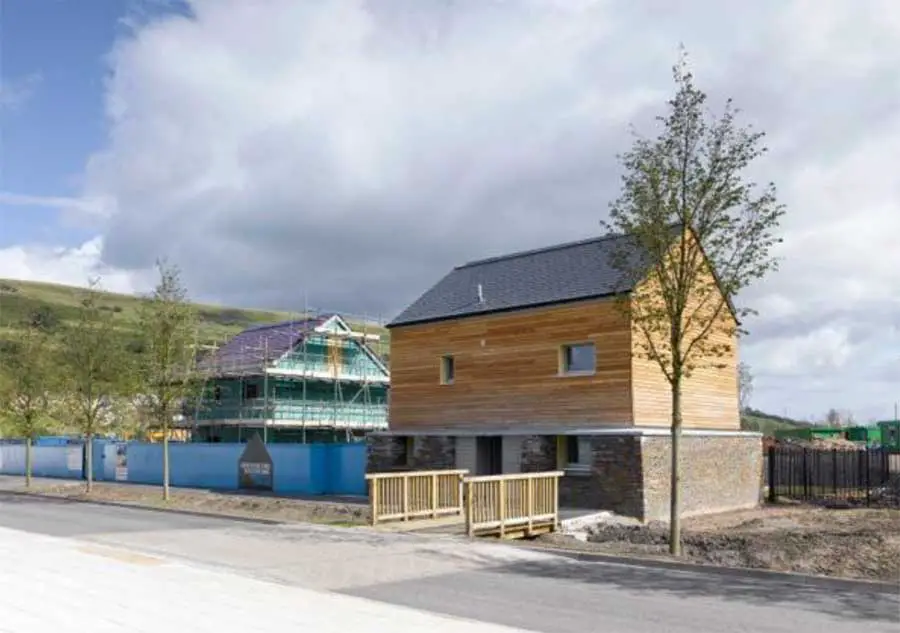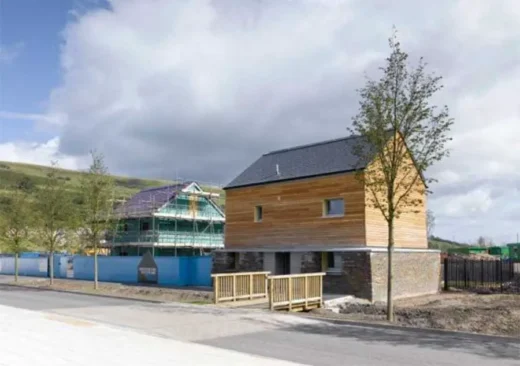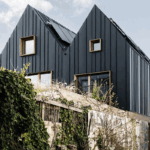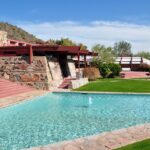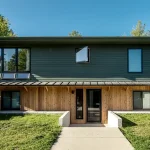Welsh Passive House, Building Contest Wales, Passivhaus home design, Eco property photo
Passive House Wales : Welsh Passivhaus home
Passivhaus Competition : Residential Development Wales design by bere:architects
post updated 22 June 2025
The Larch House
Design: bere:architects
20 Sep 2010
First UK zero-carbon Passivhaus
The first Passivhaus homes in Wales for social housing, including the UK‟s first zero carbon Passive House, completed in summer 2010. Designed by bere:architects the two progressive houses are the central features of Future Homes, a demonstration centre for sustainable development and construction that is part of the 2010 National Eisteddfod festival of Wales.
In 2009 bere:architects won a competition to design low cost houses which would showcase the Passivhaus concept and feature innovative measures for energy efficiency and eco excellence. The competition was a joint initiative by the United Welsh Housing Association, BRE, Blaenau Gwent Council and the Welsh Assembly Government. The houses are now complete and open for visitors at The Works; Ebbw Vale, a disused steelworks which is the site of the 2010 National Eisteddfod.
The new homes, called The Lime House and The Larch House, are ground-breaking in their approach to sustainability and energy efficiency. Sited next to each other, the houses are certified Passive Houses built using Welsh labour and construction materials. Their energy needs are met by harvesting heat from sunshine via extensive glazing and thermal and photovoltaic panels, and by using heat from the bodies and the electrical appliances of the occupants. Hardly any fossil fuel energy is used and The Larch House generates enough energy from the sun in the summer to fulfill all its energy requirements throughout the year. It is the first zero carbon Passivhaus in the UK.
In line with the sustainable agenda, both houses use locally sourced material and manufactured goods wherever possible. Both houses offer light, airy and comfortable living environments. They have been developed with the United Welsh Housing Association who would like to replicate the innovative features of these two houses in future affordable housing schemes, reducing their tenants‟ household energy bills and protecting people from fuel poverty. The main contractor was Pendragon and the timber frame subcontractor was Holbrook.
The project is also responsible for opening up the possibility of new manufacturing opportunities for Wales including the manufacture of a highly sustainable closed-panel timber frame system, a factory to produce wood fibre insulation and the UK‟s first specialist plant for making Passivhaus window sections. (see „Made in Wales‟ below for more information).
The ultimate aim is to create a self sufficient community at Ebbw Vale – an exemplar sustainable community for Wales. Led by BRE with the University of Wales at Cardiff and bere:architects carrying out research to help develop the vision, funding has being found for a low carbon research institute at Ebbw Vale based on the Fraunhofer institute in Germany, but with a major focus on timber technologies.
It is hoped that the institute will be part of a Sustainable Park which will support local firms in researching, testing, training and manufacturing sustainable buildings and products made from local materials. Not only will this help the local economy across a wide range of sectors from forestry to manufacturing, but it will pave the way for more sustainable homes in Ebbw Vale, and, by providing work locally, the use of private transport will be substantially reduced. More detailed information can be found below.
Contents:
1. The Larch House – A Zero Carbon Passivhaus
2. The Lime House – Simple, Locally Made and super energy efficient
3. Classic Passivhaus credentials
4. Made in Wales (additional information about materials and manufacture)
5. Construction details and note on costs
6. Who is Who
1. The Larch House – a zero carbon Passivhaus
The Larch House – garden side The Larch House is a Certified Passivhaus, it satisfies UK standards ENE 1,2 & 7, and it meets Code 6 in the Code for Sustainable Homes. This the first time that all three top standards have been reached in a single house in the UK. Sustainable Homes Code 6 classifies The Larch House as „zero carbon‟, although the architects feel more comfortable describing the house as „carbon neutral‟. With more than half of its south wall taken up by glazing, the three- bedroom Larch House is a classic Passive House, but one specifically designed to perform in the wet Welsh climate rather than a copy of European Passive Houses. All Passive Houses must be designed around the climatic conditions of their precise location.
This approach is a return to the days before mass housing developments, when cottages and farmhouses were constructed with locally available knowledge and materials to cope with the elements particular to their location. The Larch House – named after its Pembrokeshire larch cladding – is build of Welsh materials by local Welsh tradesmen. Large amounts of glazing capture all the available heat from the sun – even from an overcast winter sky. The extra glazing also creates a brighter, lighter living environment, and on valley slopes, 4 fantastic views. Solar thermal and photovoltaic panels on the roof also generate energy from the sun. The Passivhaus-certified triple-glazed and insulated windows are from Bayer in Germany.
The Bayer engineers generously trained and passed on their expertise to Welsh manufacturers inspiring them to work with bere:architects, Bill Robertson and Wood Knowledge Wales to develop a Welsh Passivhaus window which bere:architects had Passivhaus Certified in time to be installed in The Lime House. The timber frame panels from which the house is constructed were manufactured in Wales, using mainly Welsh timber.
The timber panels must fit together very tightly to satisfy Passivhaus draught-proofing and moisture control standards. To achieve this bere:architects designed the panels to include draught-minimizing details originally developed on Passivhaus developments in Germany and Austria. The final air test achieved one of the UK‟s best-ever results: almost three times better than the air change rate actually required for Passivhaus certification. Additional Passive House and zero-carbon features at The Larch House include: • Retractable external blinds to provide solar shading in the summer • A heat recovery ventilation system and towel radiators on demand switches • Energy for water supplemented by solar panels • A+ rated or better domestic appliances • Low-energy LED light fittings using only 7 watts of power!
2. The Lime House
Simple, locally made and one of the UK’s most energy efficient houses. The Lime House is still under construction.
The two-bedroomed Lime House – named after the lime render on the outside walls – follows the unfussy form of a traditional Welsh cottage. Its simple, compact shape minimises the surface area from which it can lose heat, as well as the amount of insulation it needs, which means a greater share of the budget can be spent on the quality of other elements.
Lime House uses locally sourced and manufactured goods and materials wherever possible. Welsh skills, suppliers and products have made the Lime House one of the most energy efficient houses ever built in the UK.
Architect Justin Bere believes that The Lime House is “an example of how the UK can achieve the very best quality standards, creating demand for home-produced Welsh products and skills and showing how a greener future can create a prosperous new era for the people of Wales.”
All of the windows and front door use Welsh larch timber, thermally modified in Anglesey; most of the timber for the doors, wall panels, floor slabs and roof elements is from Welsh forests; most of the insulation is made in Wales, and the roof tiles come from a factory only two miles away. The staircase, the stonework and even the solar panels have all been made in Wales.
The closed-panel timber frame system was developed by bere:architects with Holbrook Timber and uses mostly Welsh timber. The system adapts framing techniques from German Passivhaus dwellings for use with faster-growing, softer Welsh timber. The panels are filled with Welsh-produced insulation off-site then clad with two further coats: a thick layer of natural loose-fill wood fibre on the inside, and the same depth of rigid wood fibre board on the outside, rendered with a thin coat lime render.
The triple-glazed, insulated windows were developed by bere:architects with a Passivhaus window designer funded by Wood Knowledge Wales and a consortium of six local joinery companies, before being manufactured in Flintshire by Custom Precision Joinery. The window frames are made from Welsh wood and these windows are the only UK-produced windows so far to gain official Passivhaus certification.
Both houses feature Classic Passivhaus credentials Passivhaus design seeks to eliminate the need for space heating and cooling and is based on the principle that reducing heating loss to a minimum is the most cost-effective and most robust way of achieving a low carbon building. Instead of depending on expensive bolt-on renewables, Passivhaus design relies on a high quality ‘tea cosy’ effect maximising the use of super insulation and stringent draught free construction and paying meticulous attention to the removal of thermal bridges.
3. Passivhaus features
Super-insulated – to keep heat in: 48cm under the floors, 43cm in the walls and 56cm in the roof. Totally draught free – This makes sure that warm air doesn‟t leak out in the winter and cold air can‟t get in. Testing has shown that these are the most draught-free houses ever built in Wales and amongst the very best ever achieved anywhere in the the UK. Triple glazed windows – The UK‟s first ever Passivhaus Certified triple glazed windows were specially developed for the Lime House. Made in Wales they are made from Welsh larch, one of the most durable woods in the world.
They have insulated wooden frames to keep warmth in the house and avoid any condensation or mildew. Heat recovery ventilation system – A low energy heat recovery ventilation system provides ample fresh air when windows are closed in winter, saving over 90% of the heat. Super energy efficient and radiator-free – The houses are so energy efficient that there is no need for radiators. If a little heat is needed, it is provided in the fresh air supply which uses the heat from solar heated water, topped up if necessary, by means of a tiny gas boiler. Fast build – structure and fabric built in 14 weeks, before being fitted out with bathrooms and kitchen.
4. Made in Wales
The closed-panel timber frame system made by local a Welsh contractor may in time result in a new manufacturing business, and a new local Welsh factory to produce wood fibre insulation using wood from ecologically managed Welsh forests. The triple-glazed, insulated windows used in the houses were developed bere:architects with a passivhaus window designer funded by Wood Knowledge Wales, and a consortium of six local joinery companies, before being manufactured in Flintshire by Custom Precision Joinery. The window frames are made from Welsh wood and are the only UK-produced windows so far to gain official Passivhaus certification. This successful initiative could lead to the opening of the UK‟s first specialist plant for making Passivhaus window sections.
Technical Details 3 bed room specification: Timber frame manufactured by Holbrook Timber in Bridgend using mostly Welsh, FSC certified timber. Triple glazed softwood timber windows manufactured by Bayer of Germany as a certified Passivhaus window manufacturer. U-values of 0.7 for glazing, and whole unit U-value of 0.8. Senior executives from this company travelled to Ebbw Vale to oversee the installation and conducted an educational work-shop on the process of manufacture and installation to contractors and design team.
This knowledge along with guidance and design from bere:architects and Bill Robertson, and funding from the BRE and Wood Knowledge Wales has resulted in the UK‟s first Passivhaus Certified Window. Larch cladding using Welsh larch (supplied by Pembrokeshire Timber) Roofing material – Mike Camilleri & Sons (Sully, Cardiff) – Redland Cambrian inter-locking reconstituted slate. Vast majority of labour, Welsh based.
5. Cost
This is a research and development project and the 2 houses are prototypes. It is intended that lessons can be learnt for the future in rolling out this standard across other sites. The Passivhaus standard is more challenging to achieve for detached dwellings. It is possible that a terrace scenario would be more financially sustainable with respect to construction costs.
The 3 bed house works out at a unit cost of £1,614/m2 excluding prelims, compared to £1200/m2 according to RICS data for one-off detached houses over the last 10 years, measured against the same criterion.
Site preliminaries, contractor‟s profits and overheads are disproportionate when applied to just 2 units and are excluded from these costs. The 2 bed is £1,470/m2. Local weather conditions are important when calculating the figures that underpin the Passivhaus compliance as they can significantly affect the result, since a passivhaus in an exposed and misty location will require an enhanced fabric specification.
6. Who Is Who
Client:
United Welsh Housing Association
Partners:
Welsh Assembly Government
Building Research Establishment
The Works team at Blaenau Gwent County Borough Council
Architects: bere:architects
Quantity Surveyor: e-Griffin Consulting
Main Contractors: Pendragon (Design & Build) Limited
Engineers (Structural): Bob Johnson (BJSE)
M&E Engineers: Alan Clarke Engineers (Drainage) Vale
Consultants:
Code Assessor: Brooks Devlin
Window designer: Bill Robertson
CDM-C: South Wales Safety Consultancy.
bere: architects
Founded by Justin Bere in 1997, bere:architects is recognised for its elegant and imaginative design solutions, a meticulous craftsman-like approach and a passion for the principles of sustainable development. The practice is leading the UK in Passivhaus and sustainable design. Bere:architects projects are characterized by the sensitive use of modern and traditional materials and methods to deliver distinctive and contemporary architecture and design. The practice has a diverse portfolio with projects in both the public and private sectors.
BRE
BRE has been building a better world for almost 90 years through cutting edge research, consultancy and testing services. Our unrivalled knowledge in regard to sustainability and innovation is now used across the construction industry and in the corporate world creating better buildings, communities and businesses. BRE is part of the BRE Group of companies owned by the BRE Trust, a registered charity. The profits made by BRE go to the BRE Trust the largest UK charity dedicated specifically to research and education in the built environment.
Holbrook Timber Frame Ltd
Holbrook Timber Frame Ltd designs, manufactures and constructs a range of high quality timber buildings. It is a family-run business that manufactures single, self-build houses to multiple housing developments, social housing for housing associations and large commercial hotels and other structures. National Eisteddfod Festival Annual Welsh festival which this year took place at Ebbw Vale from 31 July to 7 August.
Fraunhofer Institute
Fraunhofer is Europe‟s largest application-oriented research organization. Its research efforts are geared entirely to people‟s needs: health, security, communication, energy and the environment. As a result, the work undertaken by researchers and developers has a significant impact on people‟s lives.
United Welsh
United Welsh is a not-for-profit housing association providing housing and related services to people in south Wales. They offer a range of homes including family houses, apartments and bungalows. The organisation currently manages over 4,200 homes across 11 local authorities 10
Passive House Competition Wales
Welsh Passivhaus home Contest, 2009
Designs to achieve Code for Sustainable Homes in Wales Level 5
For: Welsh Assembly and Blaenau Gwent Council
Influenced by Passivhaus concept from Germany
Two-bedroom Home Category – Shortlist
George & Tomos Architects
John Thompson & Partners
Sustainable by Design
Three-bedroom Home Category – Shortlist
Bere Architects
HLM Architects
Ty Unnos Design
Location: The Works, Ebbw Vale, Wales
Welsh Design Competition
Welsh Housing Competition : Lawrenny Sustainable Housing Development
Welsh Building Competition : Glyndwr University, Wrexham
Passivhaus Homes
Contemporary Passivhaus Home Designs – recent eco property selection from e-architect below:
Sustainable building certification Passivhaus alternative
Sustainable building certification Passivhaus alternative
Charlesworth Passivhaus, Derbyshire
Design: Studio Tashkeel Architects
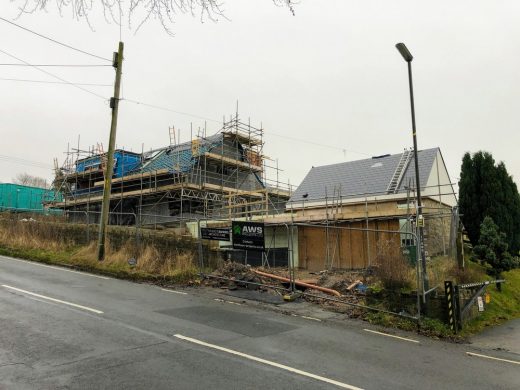
image courtesy of architects practice
Passivhaus Housing Scheme, Herefordshire, southern England
Design: Architype / Churchman Landscape Architects + ArchiHaus
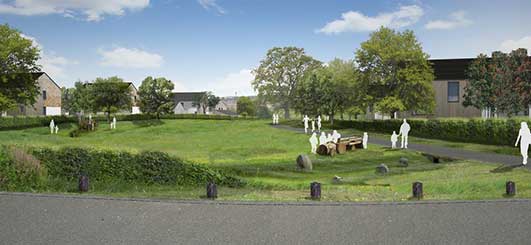
image : Architype
Hampshire Passivhaus, Self-Build Home, Using CLT Panels, Southern England, UK
Design: Ruth Butler Architects
Ringmer Passivhaus, East Sussex, Southern England, UK
Architects: Hazle McCormack Young LLP
Dundon Passivhaus, Somerset, Compton Dundon, Somerset, England, UK
Architect: Prewett Bizley Architects
Wimbish Passivhaus Scheme, Essex Homes, southeast England, UK
Design: Parsons & Whittley Architects
London Passive House
Paul Davis + Partners
Zetland Road Homes in Chorlton
Welsh Building Designs
Welsh Architecture Designs – architectural selection below:
Ruthin Craft Centre Wales
Sergison Bates Architects
Hafod Eryri – Snowdon Visitor Centre
Ray Hole Architects
Comments / photos for the Welsh Passive House Wales Architecture page welcome.

